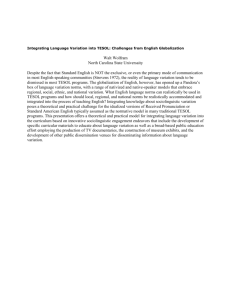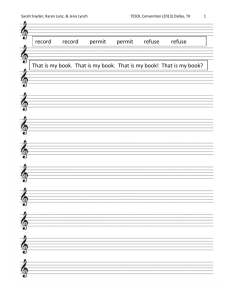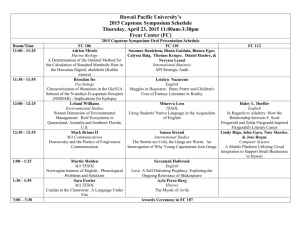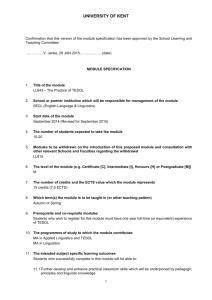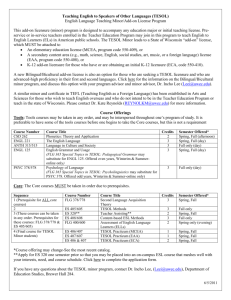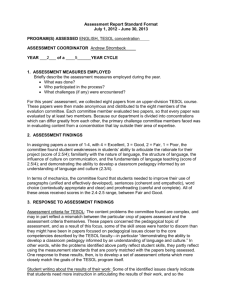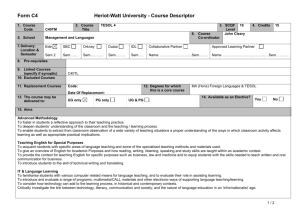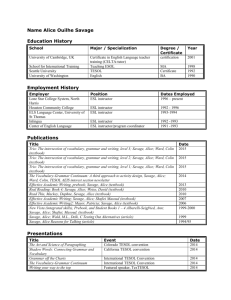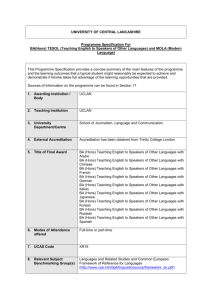2015 TESOL International Convention in Toronto, Canada, by Kate
advertisement
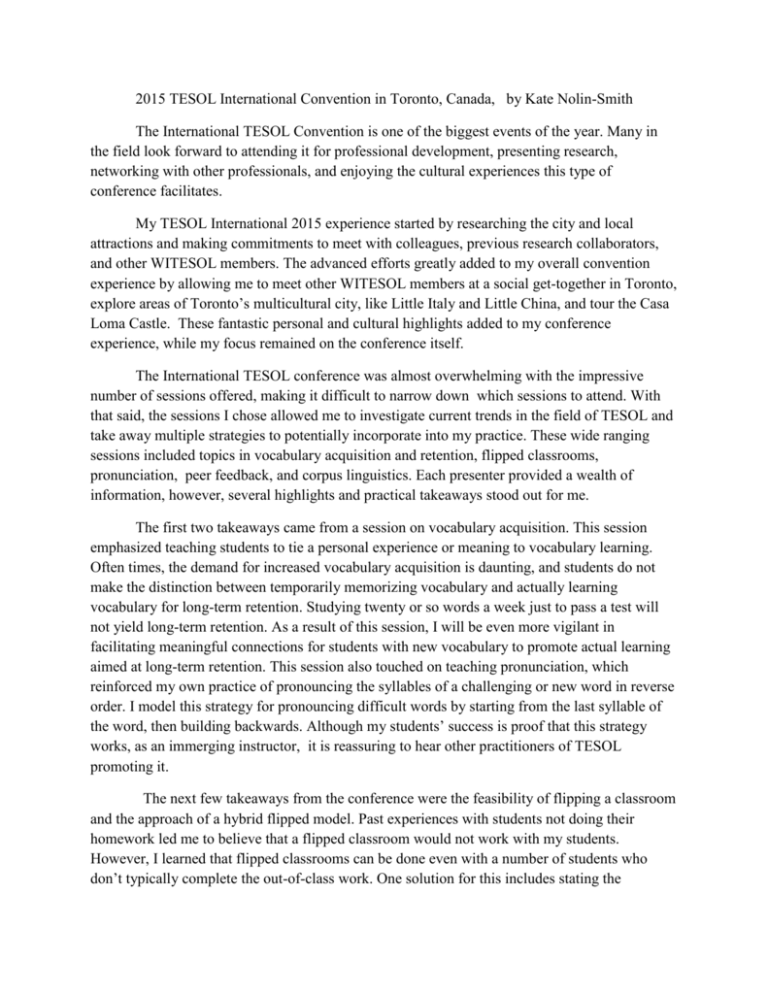
2015 TESOL International Convention in Toronto, Canada, by Kate Nolin-Smith The International TESOL Convention is one of the biggest events of the year. Many in the field look forward to attending it for professional development, presenting research, networking with other professionals, and enjoying the cultural experiences this type of conference facilitates. My TESOL International 2015 experience started by researching the city and local attractions and making commitments to meet with colleagues, previous research collaborators, and other WITESOL members. The advanced efforts greatly added to my overall convention experience by allowing me to meet other WITESOL members at a social get-together in Toronto, explore areas of Toronto’s multicultural city, like Little Italy and Little China, and tour the Casa Loma Castle. These fantastic personal and cultural highlights added to my conference experience, while my focus remained on the conference itself. The International TESOL conference was almost overwhelming with the impressive number of sessions offered, making it difficult to narrow down which sessions to attend. With that said, the sessions I chose allowed me to investigate current trends in the field of TESOL and take away multiple strategies to potentially incorporate into my practice. These wide ranging sessions included topics in vocabulary acquisition and retention, flipped classrooms, pronunciation, peer feedback, and corpus linguistics. Each presenter provided a wealth of information, however, several highlights and practical takeaways stood out for me. The first two takeaways came from a session on vocabulary acquisition. This session emphasized teaching students to tie a personal experience or meaning to vocabulary learning. Often times, the demand for increased vocabulary acquisition is daunting, and students do not make the distinction between temporarily memorizing vocabulary and actually learning vocabulary for long-term retention. Studying twenty or so words a week just to pass a test will not yield long-term retention. As a result of this session, I will be even more vigilant in facilitating meaningful connections for students with new vocabulary to promote actual learning aimed at long-term retention. This session also touched on teaching pronunciation, which reinforced my own practice of pronouncing the syllables of a challenging or new word in reverse order. I model this strategy for pronouncing difficult words by starting from the last syllable of the word, then building backwards. Although my students’ success is proof that this strategy works, as an immerging instructor, it is reassuring to hear other practitioners of TESOL promoting it. The next few takeaways from the conference were the feasibility of flipping a classroom and the approach of a hybrid flipped model. Past experiences with students not doing their homework led me to believe that a flipped classroom would not work with my students. However, I learned that flipped classrooms can be done even with a number of students who don’t typically complete the out-of-class work. One solution for this includes stating the expectation that students arrive to class prepared. Setting this expectation can be achieved by assigning a summary or oral report on the outside material. When students know they will be held accountable for outside work, they are more inclined to complete it. Another solution is designating a separate area in the classroom for students who do not complete the outside activities. There, the students can read the assigned homework material or listen to the assigned lecture on a laptop, while the other students participate in the in-class extended learning activities. This proposed strategy still provides students who fail to do their homework the same opportunity to access initial key information in a manner similar to that of a traditional classroom. This session also addressed the misconception that a flipped classroom has to be an “all or nothing” approach. On the contrary, it’s possible to create a hybrid approach by “flipping” the classroom for certain topics or projects, while maintaining traditional classroom routines for others. Admittedly, learning about the feasibility and flexibility of a flipped classroom made me reconsider incorporating this design into my future courses. Another high point from the conference came from a session on pronunciation. This session focused on fostering independent learning outside of the classroom. The presenters demonstrated how to accomplish independent pronunciation learning through activities such as self-diagnosis, drilling, practicing longer discourse, self-monitoring, and noting critical incidences. The benefits of these strategies seem obvious, but not all instructors specifically teach these strategies to students. This session was a catalyst for me to reflect on my own practice and to reconsider my focus. In the future, I will place more emphasis on the above mentioned strategies in my courses, specifically practicing longer discourse and noting critical incidence of when the student was misunderstood. Practicing longer discourse will allow students to improve suprasegmental features, while having students recognize when they are misunderstood gives them the opportunity to reflect on specific problem areas within their pronunciation. I believe these two activities will have the greatest impact on my students with lower degrees of English pronunciation accuracy. Other practical classroom strategies were offered at a round table session that focused on the use of peer feedback. Benefits of in-class peer review are recognized for both the writer and the reviewer, however, it’s imperative to address students’ apprehension to correct peer work. Instructors should emphasize that students are correcting the text, not the person. Another way to counter student apprehension is by modeling hedging. These strategies could easily be incorporated into my own courses to assist students in softening criticism and feeling more comfortable giving peer feedback. The last takeaway from the convention came from a corpora linguistics session. The presenter used will and going to as examples to demonstrate the usefulness of corpus data in teaching vocabulary. Corpus data supports that going to is more frequently used in spoken English, while will is more frequently used in written English. This might seem like a minor point for some, but if instruction is focused on teaching American English academic writing, instructors should concentrate on vocabulary that is most applicable to this area. I had never considered the order in which certain text books present vocabulary, verb tenses and form. This session left me motivated to consult corpus data in making future lesson planning decisions so that I can focus on the most useful vocabulary for students’ specific academic needs. Overall, the 2015 International TESOL convention experience provided me with opportunities to explore local culture, network with other professionals, and take away numerous strategies to include in a variety of classes. It also reinforced several practices that I currently employ in my classroom. As an emerging instructor, all four of these are highly valued! The useful information gained from the conference will be shared with colleagues this fall over a scheduled Brown Bag Lunch meeting. At that time, I’ll disseminate information from the conference along with handouts provided by presenters. My hope is that this meeting will not only facilitate the sharing of detailed information and strategies, but will also spark conversation about how attending future TESOL conferences can improve the learning experience of our students.
